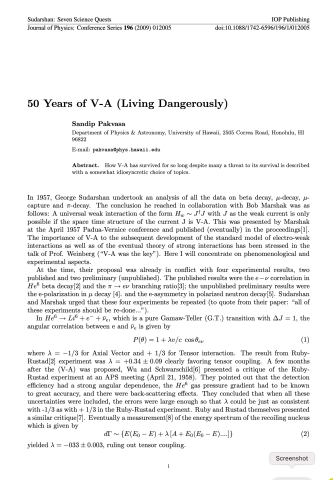50 Years of V-A (Living Dangerously)

In 1957, George Sudarshan undertook an analysis of all the data on beta decay, µ -decay, µ capture and π-decay. The conclusion he reached in collaboration with Bob Marshak was as follows: A universal weak interaction of the form H w ∼ J † J with J as the weak current is only possible if the space time structure of the current J is V-A. This was presented by Marshak at the April 1957 Padua-Vernice conference and published (eventually) in the proceedings[1]. The importance of V-A to the subsequent development of the standard model of electro-weak interactions as well as of the eventual theory of strong interactions has been stressed in the talk of Prof. Weinberg (“V-A was the key”). Here I will concentrate on phenomenological and experimental aspects.
In 1957, George Sudarshan undertook an analysis of all the data on beta decay, μ-decay, μ- capture and π-decay. The conclusion he reached in collaboration with Bob Marshak was as follows: A universal weak interaction of the form Hw ∼ J†J with J as the weak current is only possible if the space time structure of the current J is V-A. This was presented by Marshak at the April 1957 Padua-Vernice conference and published (eventually) in the proceedings[1].
At the time, their proposal was already in conflict with four experimental results, two published and two preliminary (unpublished). The published results were the e−ν correlation in He6 beta decay[2] and the π → eν branching ratio[3]; the unpublished preliminary results were the e-polarization in μ decay [4]. and the e-asymmetry in polarized neutron decay[5]. Sudarshan and Marshak urged that these four experiments be repeated (to quote from their paper: “all of these experiments should be re-done
In He6 → Li6 + e− + ν ̄e, which is a pure Gamow-Teller (G.T.) transition with ∆J = 1, the angular correlation between e and ν ̄e is given by P(θ)=1+λv/c cosθeν (1) where λ = −1/3 for Axial Vector and + 1/3 for Tensor interaction. The result from Ruby- Rustad[2] experiment was λ = +0.34 ± 0.09 clearly favoring tensor coupling. A few months after the (V-A) was proposed, Wu and Schwarschild[6] presented a critique of the Ruby-Rustad experiment at an APS meeting (April 21, 1958). They pointed out that the detection efficiency had a strong angular dependence, the He6 gas pressure gradient had to be known to great accuracy, and there were back-scattering effects. They concluded that when all these uncertainties were included, the errors were large enough so that λ could be just as consistent with -1/3 as with + 1/3 in the Ruby-Rustad experiment. Ruby and Rustad themselves presented a similar critique[7]. Eventually a measurement[8] of the energy spectrum of the recoiling nucleus which is given by dΓ∼{E(E0 −E)+λ[A+E0(E0 −E)
,.]} (2) yielded λ = −033 ± 0.003, ruling out tensor coupling.